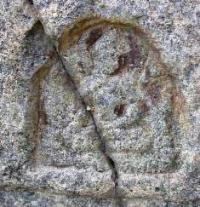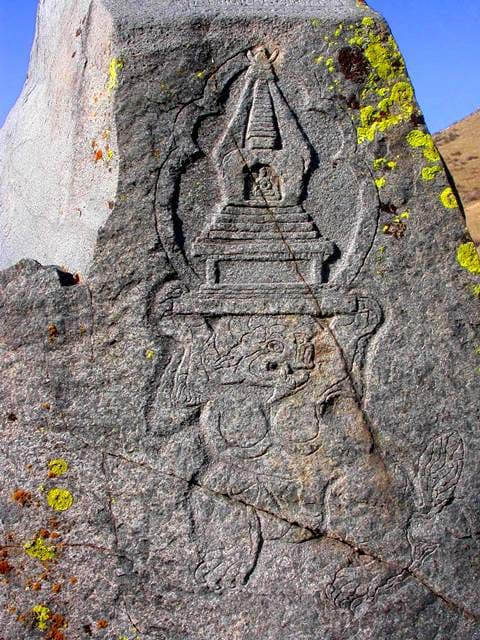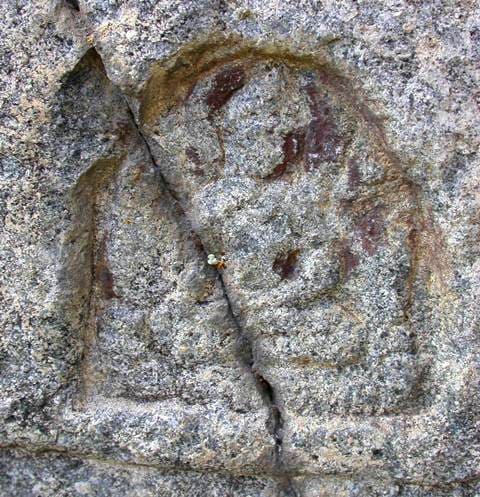You are here
Tekeli stele.

Tekeli princess or stupa near town of Tekeli.
“I have been married to a distant land,
I am the wife of the Wu-sun ruler.
My house is a hut, and there is a felt wall in it.
Dairy and meat - all food.
I live in anguish and my heart hurts
Turning into a swan, I would fly home."
Letter from Chinese Princess Emperor Xi Gyun. In 107 B.C. she was married to the Usun king.
From the materials of Zhang Jian, who was held captive by the Saks for 10 years.
Monument Kelinshektas near town of Tekeli.
Tekeli stele (suburgan) is located on the northeastern bank, 50 meters from the Kora River, 3.6 kilometers northeast of the town of Tekeli, on the territory of the town of the same name, in the western part of the junction of the Karatau ridge and the Mynshukyr mountains, at the western tip of the ridge Dzhungarskiy Alatau in Eskeldinskiy district, Almaty region.
Tekeli stele, stupa (suburgan), Kelinshektas monument, Tekeli princess, such is the list of names of the monument that has been preserved since the end of the XIXth century and has been common among the old-timers of the town of Tekeli.
One of the first Buddhist monasteries on the territory of Semirechye was built in the second half of the XVIIth century. In the western foothills of the Dzungarian Alatau on Mount Labashoky (formerly Laba), near the Karatal River.
The monastery was built by the influential Khoshut ruler Ochirtu Tsetsen Khan (1638 - 1680) or his political rival. Then the successor in Dzungaria Galdan-Boshokhtu-khan and existed for at least 80 - 90 years. During the second half of the XVIIIth - mid-XIXth centuries, the walls of all the buildings of the Oirat monastery collapsed to the ground, and at present their ruins are practically not traced in the landscape.
Among the individual traces of the existence of this Buddhist complex of Oirats that have survived to this day, the Tekeli stele, known to local historians since the end of the XiXth century under the Kazakh name Kelinshektas (‘Youth Stone’), is of great interest.
The first report about it was made in 1898 by N. N. Pantusov, a well-known Semirechensk researcher. In 2008, the Tekeli stele was examined by the expedition of the KazNII PKNN (headed by I.V. Erofeeva, field survey and documentation of the monument was carried out by A.E. Rogozhinsky).
The modern translation of the Tibetan texts was made by the Mongol specialist, candidate of philological sciences N. S. Yakhontova (IVR, St. Petersburg).
Description of monument Tekeli stupa.
The monument is a complex structure: on a stone rounded platform - 8 meters in diameter, up to 1.5 meters high. Made from a block of a large river boulder of gray sandstone with a base of 3.0 x 4.2 meters, a height of 3.6 meters.
On the upper and side (western) faces, which bear inscriptions and images. To the north of the platform, one can see a stone laying made of pebbles in the form of a ramp. In the center of the platform on the western side of the monument and under it there is a robber pit up to 1 meter deep, preserved from the end of the XIXth century.
To the east of the monument there are 5 stone, earthen mounds with a diameter of 8 - 10 meters, up to 1 meter high. Apparently, this is an older burial ground, not associated with the site of the Dzhungar period. The surface of the upper, sloping to the west, face of the monument measuring 73 x 60 x 51 cm was preliminarily processed.
On it are distinguishable inscriptions made in bas-relief and deep carving. On the upper flat surface of the stone, facing towards the river, dimensions: 73 x 60 x 51 cm, the symbol of Kalachakra and several prayer inscriptions are carved in the center.
Written in Tibetan script uchen (Tib. dbu can) and Lanza script (Tib. lantsa). The Kalachakra symbol is a complex magical monogram consisting of ten syllables or "powerful letters" (Tib. rnam bcu dbang Idan). These are seven syllable symbols: ham, ksan, ma, la, va, ra, ya - and three additional elements.
Crescent moon (visagra), disk (anusvāra or bindu) and stylized tongue of flame with three curves (nāda or tilaka). The depicted sign schematically illustrates various aspects of the Buddhist tantric teaching that all external phenomena and processes are interconnected with internal ones, that is, with the human body and psyche.
By changing himself, a person thereby influences the world around him. We can say that Kalachakra describes three levels of transformation by the individual of his own nature and the surrounding being. External, internal and other, secret, which corresponds to the symbolic comprehension of the universe, the relationship of body and mind and the mediative practice of self-improvement and bliss.
To the right and left of the Kalachakra are two more characters written in vertical Lanza script.
Above and below the Kalachakra are two horizontal lines of Tibetan text. The top line in the translation of N. S. Yakhontova contains a request to get rid of diseases and epidemics. The lower one is a Sanskrit mantra written in Tibetan letters: om ta mo nip ha tah rgyun na pa sva ha.
On the lower plane of the stone stele, a stupa is depicted in the form of a pyramid with the figure of Buddha Shakyamuni sitting inside it. To commemorate the main events of his life, stupas were built or depicted on the surface of rocks, in sacred places, one way or another connected with these events.
Of the images of eight types of stupa known in the Tibetan tradition, the one carved on the Tekeli stele most of all resembles the Stupa of Enlightenment. This Stupa is supported from below by a snow lion standing on its hind legs - one of the main symbols of Tibetan Buddhism.
In modern and recent times, the snow lion has become the national symbol of Tibet, its image can be seen on the national flag, coins, seals and stamps of this country. In the iconography of Buddhism, the image of eight lions supporting the throne of Buddha Shakyamuni in eight cardinal directions is repeatedly found.
In this case, the meaning of the snow lion is to maintain the Stupa of Enlightenment. In general, the images and inscriptions engraved on the stele do not have a common meaning. Each of the elements discussed above has a separate function here, so the entire composition can only be considered as a set of favorable symbols (Erofeeva, 2017, pp. 38-39).
The suburgan stone is currently protected by the state as a monument of local importance. It is included in the State List of Local Historical and Cultural Monuments of the Almaty Region; 2010 (No. 1511) under the inaccurate title “The Rock Image “Buddha”” with an erroneous dating of the Xth – XIIth centuries.
Geographical coordinates of Tekeli stupa (suburgan): N44°52'41.15" E78°48'37.63"


Authority:
Pantusov N. N. "Antiquities of the Kopal County". PTKLA. Issue IV. Tashkent, 1899. S. 14 - 15.
Erofeeva I.V. "Buddhist monasteries of the Oirats in Semirechye (mid-17th - mid-19th centuries" Mongolika - XVIII. St. Petersburg. Petersburg Oriental Studies, 2017. P. 35 - 47.
Date of drawing up the card, personal data of the compiler. October 2018 A.E. Rogozhinsky, Candidate of Historical Sciences, Leading Researcher of the Research and Restoration Laboratory "Crimea Island", Almaty.
Photos by
A.E. Rogozhinsky.







